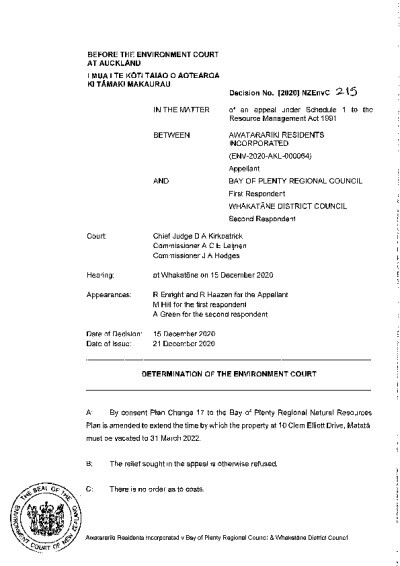
Date
Geographical Area
Pacific
Countries
New Zealand
Case Name
Awatarariki Residents Incorporated v Bay of Plenty Regional Council
Case Reference
[2020] NZEnvC 215
Name of Court
Environment Court of New Zealand
Key Facts
On 18 May 2005 a storm triggered a 300,000m3 debris flow in the catchment of the Awataraiki Stream at the western end of the settlement at Matatā. The debris flow caused significant damage to land and transport infrastructure, as well as damaging 87 properties and destroying 27 homes.
Ten years later, a hazard and risk assessment identified a high risk to life and property during a future debris flow, the return period for which was estimated to be 40-80 years. For this reason, the Regional Council concluded that the area was subject to a significant natural hazard which precluded any form of permanent settlement. A managed retreat programme was determined to be the most effective measure to reduce the risk. This involved re-zoning areas of Matatā from residential to coastal protection (by changing the Whakatāne District Plan and the Bay of Plenty Regional Natural Resource Plan), which would terminate any existing use rights and prohibit residential activity.
This proceeding was bought by Awatarariki Residents Incorporated – the residents of the area. They questioned the lawfulness of the Council’s actions surrounding re-zoning and the managed retreat, including whether the Council had jurisdiction to remove existing use rights, if the changes were contrary to the Resource Management Act 1991 (RMA), an abuse of public power, had adverse impacts which were disproportionate to the risks being managed, and were inappropriate, inefficient or ineffective in terms of s 32 of the RMA.
Ten years later, a hazard and risk assessment identified a high risk to life and property during a future debris flow, the return period for which was estimated to be 40-80 years. For this reason, the Regional Council concluded that the area was subject to a significant natural hazard which precluded any form of permanent settlement. A managed retreat programme was determined to be the most effective measure to reduce the risk. This involved re-zoning areas of Matatā from residential to coastal protection (by changing the Whakatāne District Plan and the Bay of Plenty Regional Natural Resource Plan), which would terminate any existing use rights and prohibit residential activity.
This proceeding was bought by Awatarariki Residents Incorporated – the residents of the area. They questioned the lawfulness of the Council’s actions surrounding re-zoning and the managed retreat, including whether the Council had jurisdiction to remove existing use rights, if the changes were contrary to the Resource Management Act 1991 (RMA), an abuse of public power, had adverse impacts which were disproportionate to the risks being managed, and were inappropriate, inefficient or ineffective in terms of s 32 of the RMA.
Decision and Reasoning
Despite these questions being raised by the residents, the Court did not need to address them. This is because Awatarariki Residents Incorporated – with the exception of the Whalley family – reached a compromise with Council surrounding their voluntary managed retreat prior to the hearing. Instead of ruling on the township as a whole, the Court exclusively addressed the issue raised by the Whalley family during negotiations with the Council: whether they should be allowed to continue to occupy their property for a further year.
The Court held that extending the date on which the Whalley’s existing use rights would be terminated, while not ideal, was not contrary to the principle of reducing risk to an acceptable level as soon as practicable. They also held that an early resolution of the appeal regarding the Plan would shorten the timeframe for reducing risks for all.
In terms of the changes to the plan, the Court was satisfied that the situation at Matatā justified the Council’s proposed changes in respect of managed retreat. They did not set out the reasoning for this decision, stating that “we do not presume to set out any reasoning which will necessarily apply to any other case”.
The Court held that extending the date on which the Whalley’s existing use rights would be terminated, while not ideal, was not contrary to the principle of reducing risk to an acceptable level as soon as practicable. They also held that an early resolution of the appeal regarding the Plan would shorten the timeframe for reducing risks for all.
In terms of the changes to the plan, the Court was satisfied that the situation at Matatā justified the Council’s proposed changes in respect of managed retreat. They did not set out the reasoning for this decision, stating that “we do not presume to set out any reasoning which will necessarily apply to any other case”.
Outcome
The Whalley family was allowed to remain for an additional year.
Link
Disclaimer
This case law summary was developed as part of the Disaster Law Database (DISLAW) project, and is not an official record of the case.
Document
Document